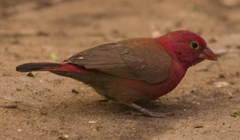| Image | Common name | Scientific name | Distribution |
|---|
 | Red-billed firefinch | Lagonosticta senegala | Democratic Republic of the Congo, Uganda, Kenya, Angola, Zambia, Mozambique, South Africa, Malawi, Nigeria, Senegal, Gambia, Cameroon, Chad, Sudan, Eritrea and Ethiopia |
 | African firefinch | Lagonosticta rubricata | Senegal east to Ethiopia then south to the Democratic Republic of Congo and Tanzania south through Mozambique to the Eastern Cape province of South Africa. |
 | Jameson's firefinch | Lagonosticta rhodopareia | Angola, Botswana, Chad, The Democratic Republic of the Congo, Eritrea, Eswatini, Ethiopia, Kenya, Malawi, Mali, Mozambique, Namibia, South Africa, South Sudan, Tanzania, Uganda, Zambia and Zimbabwe |
| Mali firefinch | Lagonosticta virata | Western Africa |
 | Rock firefinch | Lagonosticta sanguinodorsalis | central Nigeria |
 | Chad firefinch | Lagonosticta umbrinodorsalis | southwest Chad where it is fairly common and northeast Cameroon |
 | Black-bellied firefinch | Lagonosticta rara | Benin, Burkina Faso, Cameroon, Central African Republic, Chad, The Democratic Republic of the Congo, Côte d'Ivoire, Ghana, Guinea, Kenya, Liberia, Nigeria, Senegal, Sierra Leone, South Sudan, Togo and Uganda |
 | Bar-breasted firefinch | Lagonosticta rufopicta | Gambia and southern Senegal east to western Uganda and eastern Kenya |
 | Brown firefinch | Lagonosticta nitidula | Angola, The Democratic Republic of the Congo, Zambia, southern Tanzania and northern areas of Namibia, Botswana and Zimbabwe |
 | Black-faced firefinch | Lagonosticta larvata | Benin, Burkina Faso, Cameroon, Central African Republic, Chad, The Democratic Republic of the Congo, Côte d'Ivoire, Ethiopia, Gambia, Ghana, Guinea-Bissau, Mali, Niger, Nigeria, Senegal, Sierra Leone, Sudan, Togo and Uganda |
|









